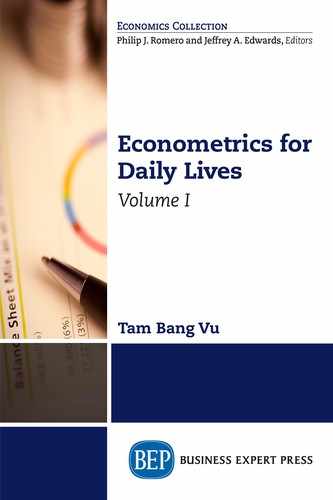If you think econometrics is boring, think again. Econometrics can be enjoyable if you focus less on the abstract theory of the subject and more on the applied topics so that you can solve your everyday problems.
For example, you might wish to know the relationship between the cost of buying a house in your hometown versus renting the same house so that you can decide whether to buy or to rent. You might also wish to know how increasing prices of certain goods affects the revenue of your company. This textbook will help you analyze these relations. The book is written for first-year MBA students, upper-division undergraduate students, businesspersons, and other readers who wish to apply econometric concepts to improve their lots in everyday activities.
An Applied Approach to Econometrics
The focus of this textbook is Applied Econometrics, so the only prerequisites for the course are high school statistics and college algebra. The book is not an intimidating 400- to 600-page textbook. The theoretical sections are made easy by discussing only the concepts that are required to conduct basic data analyses. This enables the text to be quite informative while consisting of only two volumes of less than 150 pages each, both of which can be easily covered in one trimester or one semester.
To make the book more accessible, Microsoft Excel is the only econometric package required to perform all applications in the book. Two supplementary folders are provided. The first folder is named Data Analyses and contains all text and Excel files that accompany the Data Analyses sections in this book. The second folder, Data for Exercise, comprises all data for the exercises in the text.
A third folder, Answers to Exercises, will be provided to instructors after a book order is received.
This book discusses most of the econometric methods frequently used in practice. Volume One introduces elementary and intermediate-level topics such as simple linear regressions, multiples linear regressions, ordinary least squares, generalized least squares, cross-sectional data, simple time-series techniques, and panel data analysis. Volume Two discusses several advanced topics and applied issues in econometrics such as nonlinear forms, instrumental variables, advanced time-series techniques, simultaneous equation estimations, limited dependent variables, regression discontinuity analysis, and difference-in-difference estimations.
The Fictional Characters in This Book
A team of professors and classmates is introduced in this textbook to provide you with an enjoyable learning experience.
The professors:
Professor Empirie is an empirical researcher. She teaches all Data Analyses sections in this class.
Professor Metric is a theoretical econometrician. He is responsible for explaining any theoretical concept in this class.
The professors guide you step by step through the chapters while providing plenty of daily-life examples to make the theoretical concepts easy to understand.
The Students:
(i) Touro works for a tour-guide company called Tourista.
(ii) Booka is the owner of an online bookstore called Bookwebki.
(iii) Taila works for a tailoring shop called Tailorie.
(iv) Invo works for an investment company called Investos.
The students show you how they apply their knowledge of econometrics into solving various problems in their daily lives.
